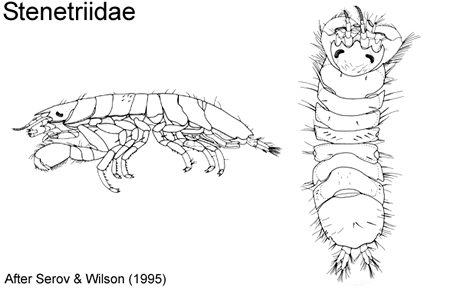 |
||||||
|
|
|
|
|
|
Australian Isopoda: FamiliesS.J. Keable, G.C.B. Poore & G.D.F. WilsonStenetriidae Hansen, 1905 Stenetriidae Hansen, 1905b: 46. -Serov & Wilson, 1995: 46. Description. Body. Body shape without loss or gross modification of appendages on one side of the body; in dorsal view without peduncular articles of antenna 1 or 2 contiguous with coxal margins. Head. Head not capable of lateral rotation (laterally encompassed, abutting or fused to pereonite 1). Antenna 1 inserting on head anteriorly and/or dorsally to antenna 2, minute or well developed; not as follows: reduced to 2 articles with second article expanded and scalloped. Antenna 2 well developed; peduncle article 3 subequal in length and colinear to other proximal peduncle articles. Mouthparts not forming suctorial cone or proboscis. Mandible not projecting anteriorly and together forceps-like; palp present. Pereon. Pereonites 6-7 pereonite 7 distinct dorsally, free. Coxae not extending ventrally and laterally to overhang the coxa-basis articulation of the pereopods. Pereopods 6-7 pairs readily apparent; 1-3 or 1-7 not prehensile. Pereopod 1 subchelate, dactylus and propodus opposing each other. Pereopods 5-7 without flattened setose articles andor dactyls modified or absent. Pleon / Pleotelson. Pleonites and pleotelson with pleonites 3-5 fused without lateral sutures, pleotelson fused with pleonites 3-5, pleonites 1 and 2 free but may be only small rings or cuticular bars visible ventrally. Pleopods 5 pairs present (males), or 4 pairs present (females); pleopod 3 opercular in males and females, pleopod 1-2 small and not opercular. Pleopod 2 of males consisting of an enlarged peduncle, a geniculate endopod and a small muscular exopod; peduncle distal margin not enlarged, exopod inserting distomedially; appendix masculina length and width subequal to endopod proximal article, ornamented distally. Uropods positioned distally on pleotelson; distinct from pleopods, not forming operculum over pleopodal chamber (although may be folded ventrally below pleotelson). Peduncle not forming an elongate clavate article with rami reduced or absent. Endopod not claw-like (acute and recurved) andor posteroventral in position. Exopod not folded dorsally over pleotelson. Distribution and generic composition. See Kensley et al. (1996).
Cite this publication as: 'S.J. Keable, G.C.B. Poore & G.D.F. Wilson (2002 onwards). 'Australian Isopoda: Families. Version: 2 October 2002. https://crustacea.net'. |
|
|
|
|
|
|
|
|
|
Copyright © Australian Museum, 2002 - 2003
Australian Museum website
